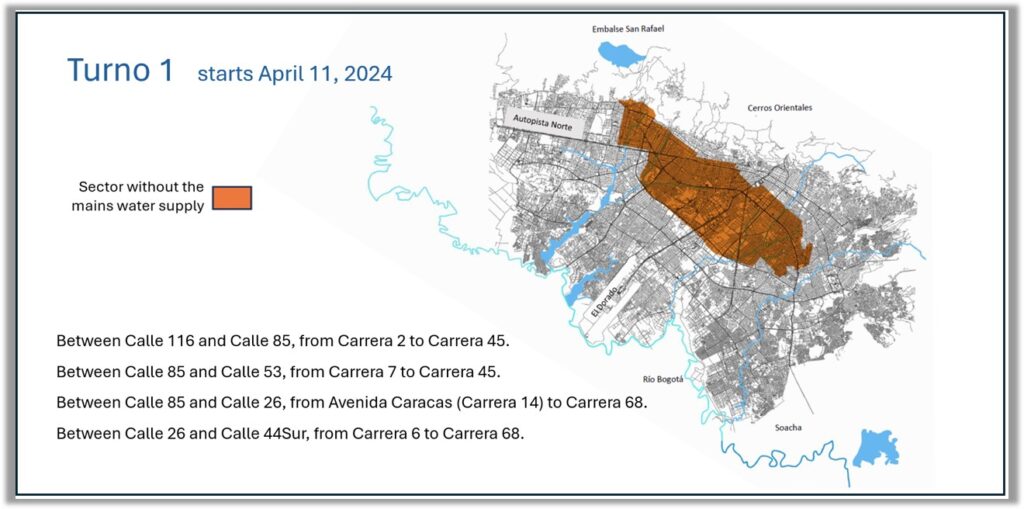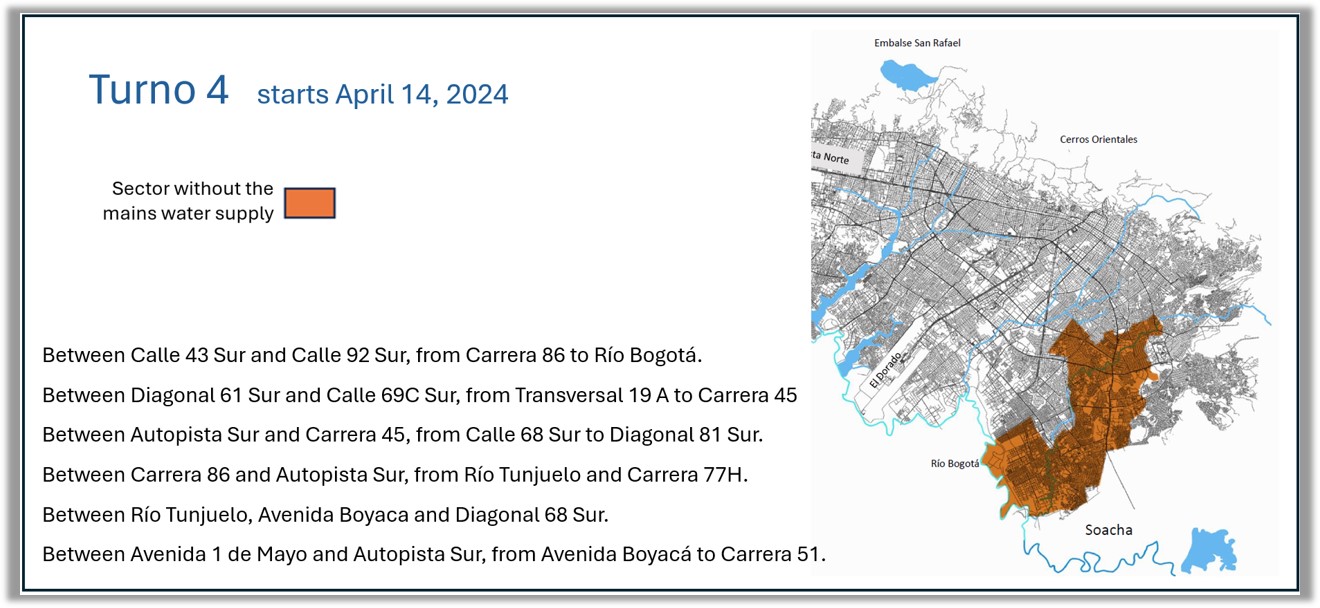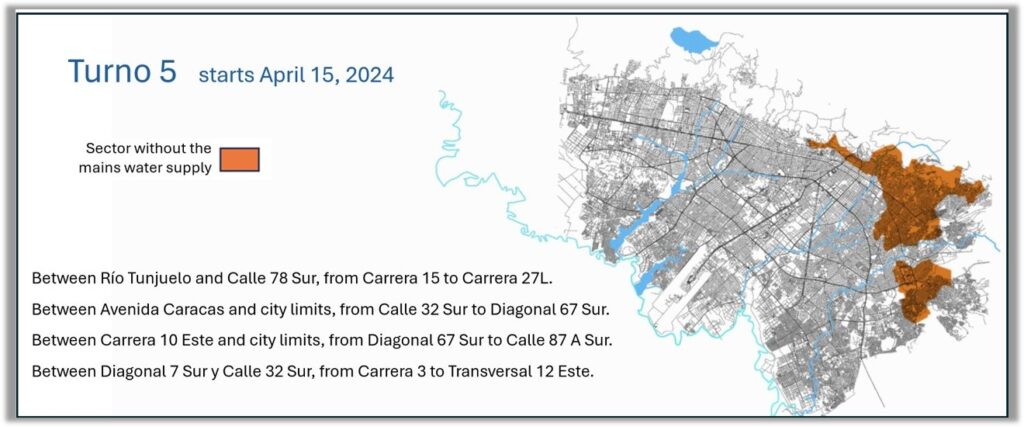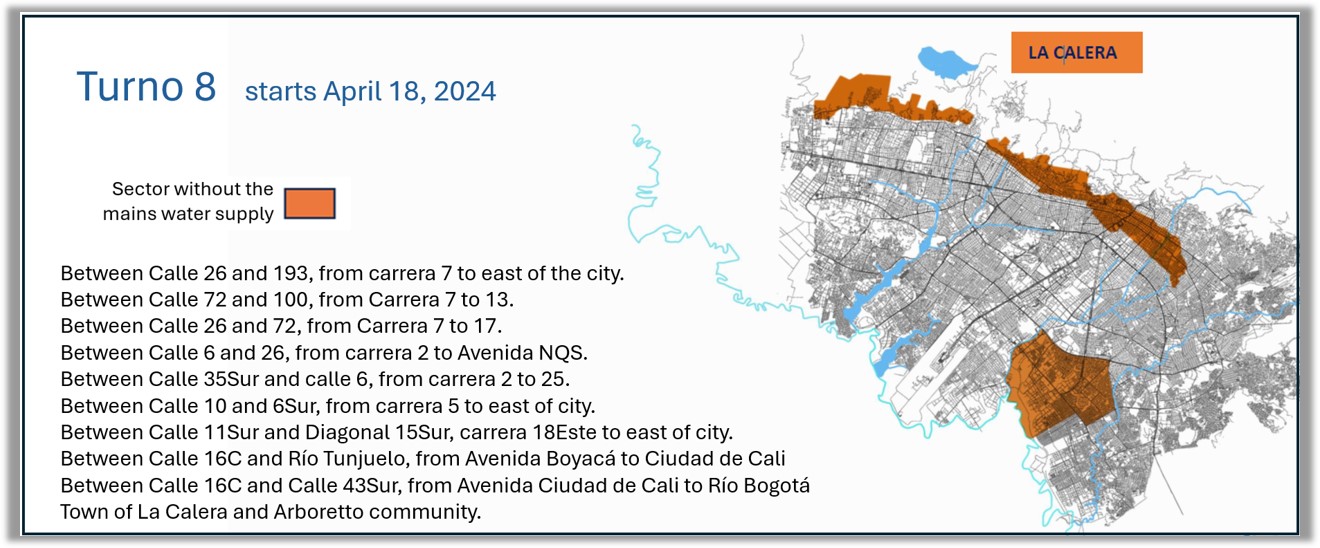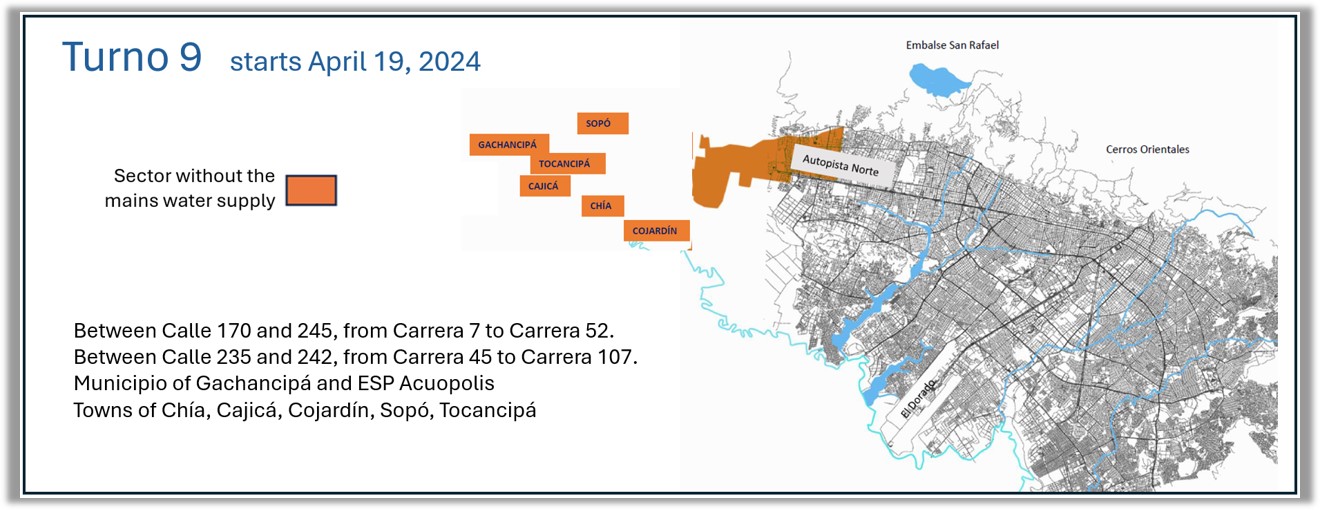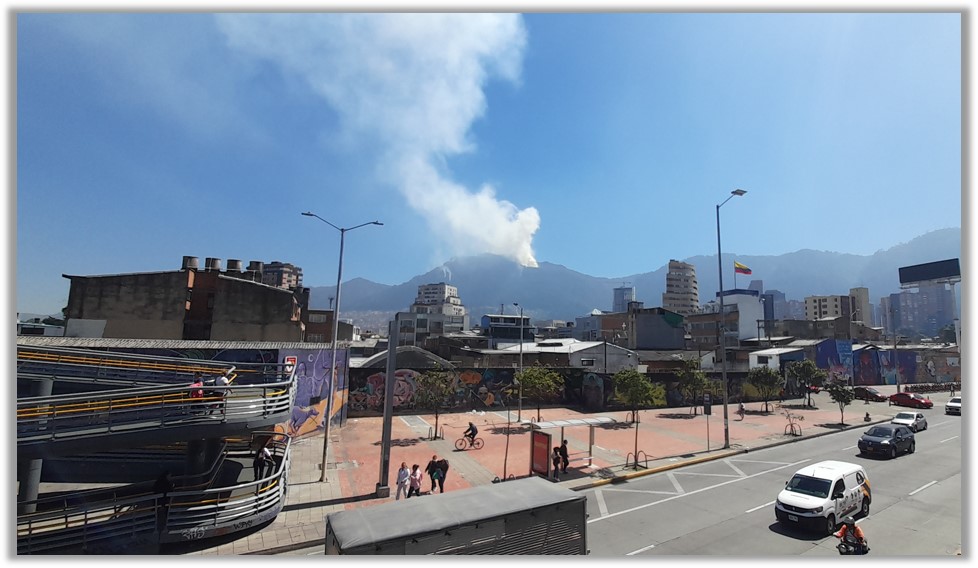Bogotá water cuts: all you need to know

Starting April 11, Bogotá will see rolling water rationing because of record-low levels in the reservoirs that feed the city. No need to panic. Yet.
Posted April 2024.
See related post: Bogotá Weather, Anyone´s Guess…
Any questions? Contact Colombia Corners at colombiacorners@gmail.com
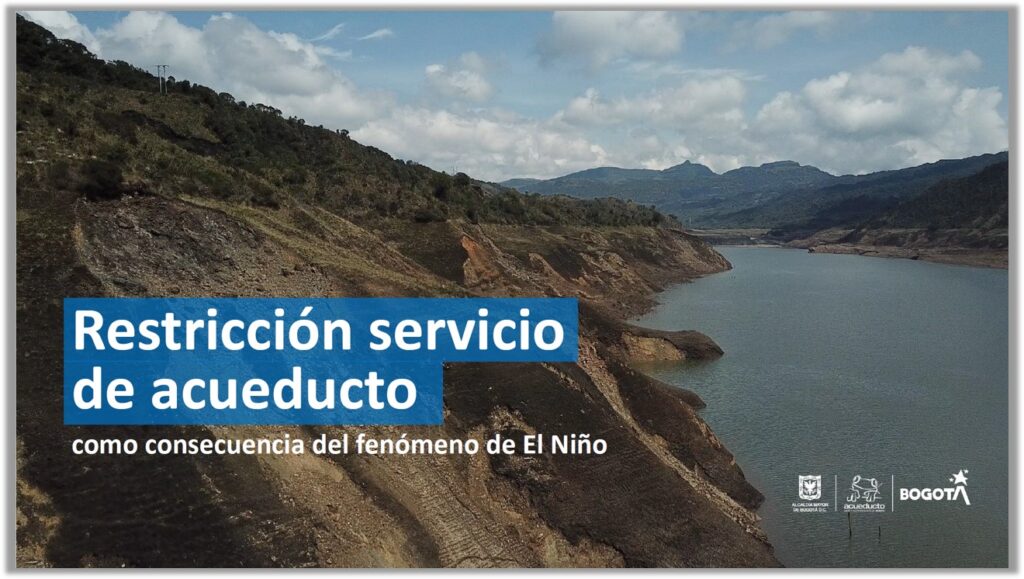

Caramba! I thought it always rained in Bogotá…how can we run out of water?
Colombia’s capital always sees a drier spell between Christmas and Easter, but with some rainfall. So far, 2024 has seen less showers – great for sitting out in cafes – but and now we are paying the price. This is down to the ‘El Niño Southern Oscillation’, a cyclical climate phenomenon brewing in Pacific the that brings warmer weather worldwide, and drought to northern South America. Lack of rain has depleted Bogotá’s reservoirs to critically low levels. According to Bogotá’s mayor, Carlos Fernando Galán, the Chingaza chain of reservoirs – which supply 70% of the city’s water – are under 17% capacity and could run dry within 30 days without urgent measures.
When can I expect the tap to run dry?

Maybe never. It’s important to note that buildings in Bogotá only received full-time mains water (‘acueducto’) in the last few years… before that we relied 50% on water stored in tanks, usually of the roof, but sometimes pumped from underground cisterns. Most buildings and houses still have on site storage to cover any mains cut of 24 hours. Your own situation depends on where you live, the reserve storage capacity, and how much the next-door flats are using. And with recent improvements in the city supply, many residential blocks have reduced their storage capacity. So yes, you might run out.
How will the mains water be cut?
EAAB, the water board for Bogotá, has divided the city into 9 sectors. Each sector will have a 24-hour mains water cut every 9 days (so 3 per sector per month) starting in Sector 1, 8am, Thursday 11 April, 2024. Note that sectors do not exactly overlap with city boundaries (districts, barrios etc) so you need to check your own address with the sector details. You can download the full details here on the EAAB website or see the addresses and maps for each sector at the end of this post.
I’m not sure what sector I am in? How can I check?
The Mayor’s office has an online map here where you can zoom on on your actual address, and the EAAB Water Company has a WhatsApp number ‘Chatico’ +57 316 023 1524 where you can access a menu with the latest water cut info: send a message with the word ´cortes´and the latest info will appear.
If you use X (Twitter) then the EAAB handle is @AcueductoBogota
You can also find information on www.acueducto.com.co, the official website of EAAB Water Company.

How long will it last? Should I be worried?
Even if your building/house/hotel has a reserve tank, still expect a shortage or lower water pressure, and some inconvenience. In the longe term, there are signs the El Niño effect are weakening and Colombia’s weather service, IDEAM, is already predicting La Niña for 2024. The La Niña climate effect – which sometimes follows El Niño – brings cooler climes and increased rainfall to Colombia. May is traditionally the start of the first yearly wet season in Bogotá.
In fact, it is already raining up on the páramo that feeds the lakes and reservoirs above Bogotá. But one aspect of this Andean marshy moorland is its ginormous sponge-like effect; it could take months for the dry ground to soak up rainfall before the reservoirs fill up. Water cuts could affect Bogotá for much of 2024, even if the storms arrive.
A likely scenario for May is: water, water everywhere – except in the tap!
A worst-case scenario is that the rains are late, or demand for water outstrips demand, and shortages become extreme; this will probably more affect the poor barrios and informal settlements, mostly on the south side of the city, and could lead to protests and civil unrest. Everyone is hoping for rain.
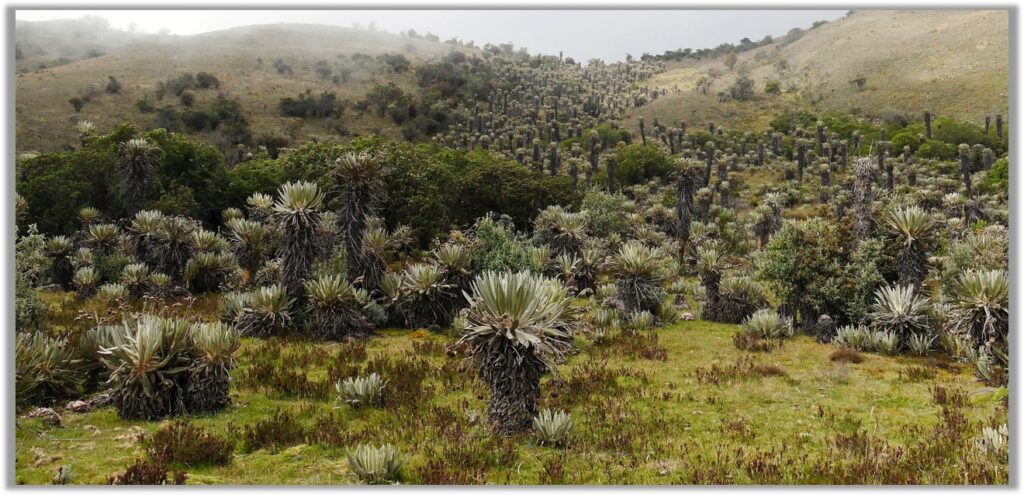
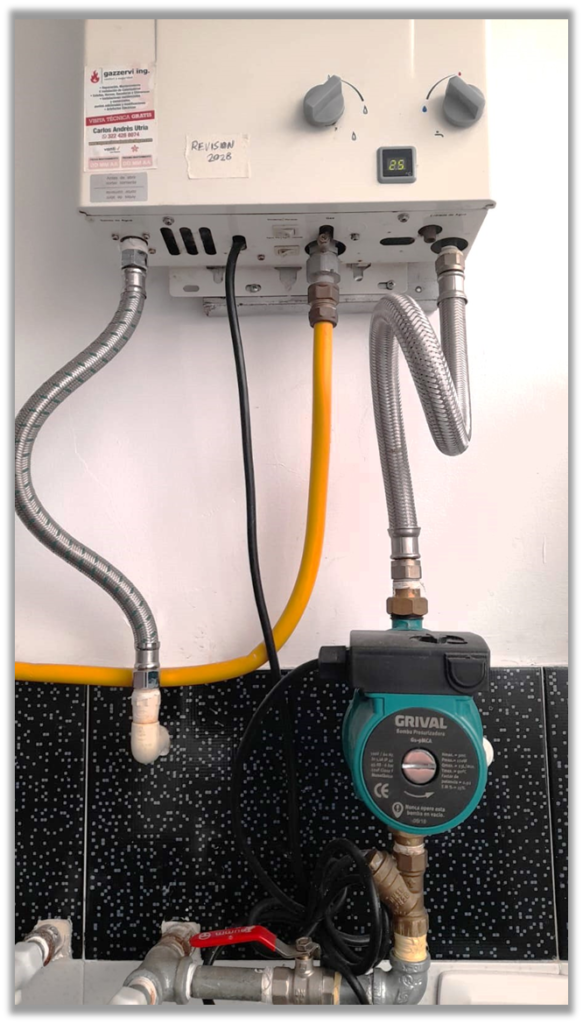
Why does my water heater stop working?
During water cuts, you will likely be running off the building reserve tank. You might notice the diffrence, but your gas water heater will. Newish water heaters (calentador de paso gas) are calibrated to run on mains water pressure, which is usually much higher than the pressure from the building reserve tanks. Some heaters fail to ignite at low pressures.
How to get round this:
- Shower early or late when your neighbors aren’t. (Pressure goes down when everyone has the tap on).
- Try adjusting the dials (water and gas) on the front of the heater unit, as on the photo to the right.
- For a long-term fix, you can install a booster pump before the heater unit, see also the photo right. This can make your water heater more efficient.
- As a last resort, heat some water on the stove or man up and have a cold shower.
How effective will the water cuts be?
Good question. The mayor’s projection is to reduce mains water consumption by 2 cubic meters per second, amounting to 173 million liters a day, a worthy goal. But will it work?
Over 90% of water consumption is residential, and most houses and flats have reserve tanks. Even in poorest areas of the city, many households have a plastic tank on the roof. The question is then; how much water will we actually save if these tanks just refill after the water comes back on ….?
The biggest impact of water ‘rationing’ will be to create publicity and encourage people to reduce their water consumption. The Mayor and EAAB will give regular updates on how much the city saves…

Can I drink from the tap?
Despite the propaganda online, Bogotá tap water is not reliable to drink, mostly because the aforementioned storage tanks in many buildings have holes in the lid and accumulate dead pigeons. Particularly during the cuts, when we use more tank water, find a way to treat the water; boiling, a drop of chlorine, or a filter jug (jarra con filtro purificador) will do the trick, if you don’t want to buy bottled water.
Ways to save water…
OK, so if we all agree with the urgent need to save water, here’s how:
1: Stop Leaks
Water leaks account for by far the highest loss, and mostly occur in the toilet cistern. You can usually adjust the float to use less water in the cistern. If you do find leaks, change the cistern plumbing. Even if you are not a plumber, it is easy to fit a plastic tap that can isolate the water supply to the cistern, also useful if you are travelling and want to isolate the cistern supply. See below.

2: Shower with a friend.
A nice idea! Bogotá’s aqueduct company, EAAB, recommends reducing your shower time to ‘five minutes’, which is three minutes shorter than the ‘average’ eight minutes according to CDC (seriously, who measures this?). Showering with cold water in Bogotá would shorten your shower to around 30 seconds but make it less likely to be shared it with a friend.
3: Don’t wash dishes the Colombian Way.

Colombians insist on washing the dishes under a running tap, a habit that my (unreliable) anthropologist friend says stems from their indigenous ancestors squatting by a river to rinse off their clay pots. Obviously filling two (smallish) bowls with water and soaping, then rinsing, is the way to go.
4: Collect rainwater
Despite the drought, it is raining (a bit) and if you have a patio or access to a gutter downpipe (bajante) you can buy a small tank and collect some rainwater, this also helps reduce your water bill in the long term.
Don’t drink this water (it can carry disease from muck on the roof) but use a bucket to fill the washing machine (if you have a top loader), cook, clean, wash the car, water the plants, or flush the toilet. Our small rainwater tank (150 liters) also acts as an extra reserve during mains water cuts.
You can also use a bucket to collect shower water and use this for cleaning and flushing.
Know your Sector and Turno!
Remember: each of the 9 sectors of Bogotá has a turno for water cuts that starts at 8am and last for 24 hours. The following information is from the Mayor’s Office and EAAB, the water company for Bogotá, and subject to change. Turnos repeat every 9th day, so Turno 1 will be on April 11, April 20, and April 29.
WhatsApp number ‘Chatico’ +57 316 023 1524 where you can access a menu with the latest water cut info: send a message with the word ´cortes´and the latest info will appear.
